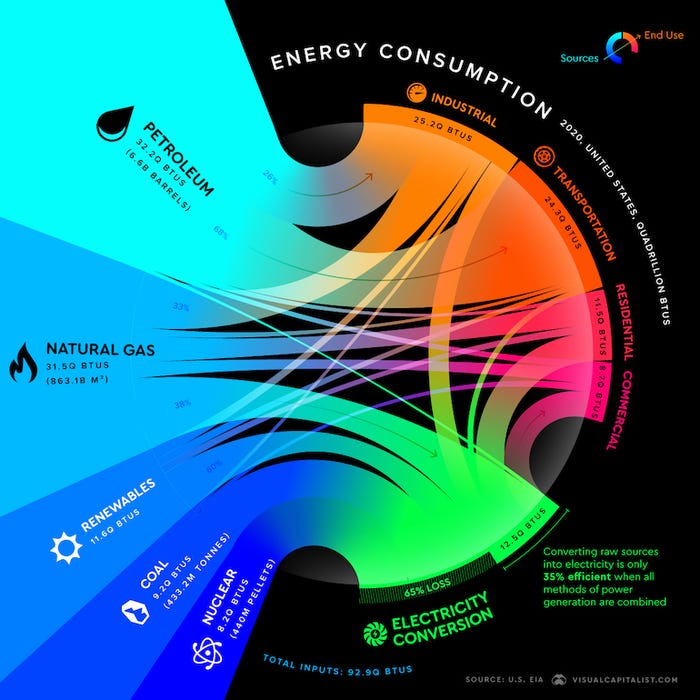Goodbye to Coal? Hello to Wind and Solar! Clean Energy Is Growing
A new way of seeing US energy use and consumption spells out clean energy growth, even where fossil fuels dominate.
July 9, 2021

In 2019 and again in 2020, the United States’ domestic energy production was greater than its consumption. This hasn’t happened since 1957. The numbers for 2020 were obviously impacted by the COVID-19 pandemic as US energy production dropped 5 percent and consumption dropped by 7 percent. Following this dip, the levels of US energy production are both expected to continue to increase.
Data from the EIA (Energy Information Administration) breaks down US energy consumption by source and provides an indication of how much each sector relies on various energy sources. The Visual Capitalist has created a comprehensive graphic that details US energy sources and consumption in 2020. In this graphic, the energy amounts are equalized and measured in quadrillion BTUs (British thermal units), which are also known as quads. A quad is an enormous amount of energy—it is equivalent to the energy contained in 183 million barrels of petroleum or 36 million metric tonnes of coal.

From the above figure, 79 percent of domestic energy consumption still comes via fossil fuels. Petroleum is the prime-mover for 90 percent of transportation, and in the industrial sector natural gas and petroleum make up 74 percent of direct energy consumption. Meanwhile, coal consumption has decreased more than 58 percent since its usage peak in 2005. This is good news as coal is the dirtiest fossil fuel. Renewable energy has increased for six straight years, but (along with nuclear) still only makes up 21 percent of US energy consumption, while fossil fuels are responsible for 79 percent.
Aside from petroleum, which is primarily used for transportation, the energy from both nuclear and natural gas is converted into electricity. The conversion, transmission, and distribution of electricity turn out to be inefficient, and 65 percent of the energy available is wasted in the process. The use of renewable resources such as wind and solar, distributed nearer to the electricity’s end-user can greatly improve the energy waste. The Biden administration has said it aims to reduce greenhouse gas (GHG) emissions by 50% by 2030 (from 2005 emission levels)—to do so will require a continuing shift away from fossil fuels and towards renewable and nuclear energy.
Kevin Clemens is a Senior Editor with Battery Technology.
About the Author(s)
You May Also Like





